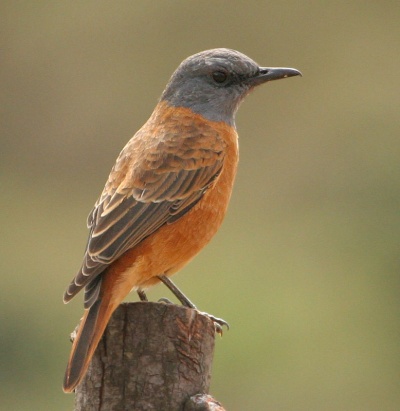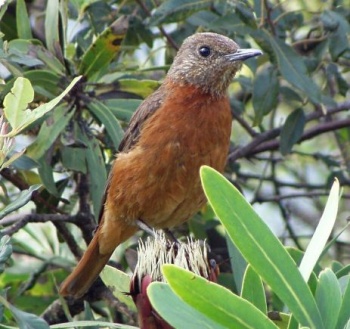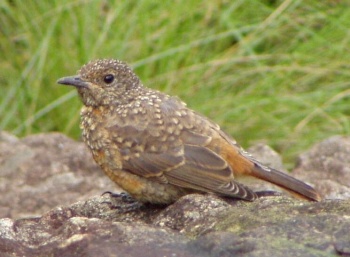- Monticola rupestris
Identification
Length 21-22 cm (8¼-8¾ in), mass about 60 g.
Adult male: Blue-grey head and throat contrast with rufous-orange underparts. Upperparts are mostly dark brown and rufous. The bill is black, the eyes brown, and the legs brown to black.
Adult female: Similar to the male, except that the underparts are duller and the head is mainly brown, streaked black, with white markings on the face and throat.
Juvenile: Brown with buff mottles above, and rufous with black mottles below.
Similar Species
The male Sentinel Rock-Thrush is similar to the male Cape Rock Thrush, but the blue grey of the head extends to the back and upper breast. The male Short-toed Rock-Thrush has a blue-grey back and a whitish crown.
Distribution
Eastern and southern South Africa, Lesotho and eSwatini. Some altitudinal migration in populations that breed at high altitudes.
Taxonomy
This is a monotypic species[1].
Habitat
Cliffs and rocky slopes, and sometimes human settlements.
Behaviour
Solitary, in pairs, or in family groups. Attracted to burnt vegetation. Perches on rocks, shrubs or poles to sing or when alarmed.
Diet
Forages mainly for invertebrates on the ground; also eats seeds and fruit.
Breeding
The cup-shaped nest is built in a crevice or on a ledge on a cliff or building; Two to four eggs are laid in summer (September to February).
References
- Clements, J. F., T. S. Schulenberg, M. J. Iliff, D. Roberson, T. A. Fredericks, B. L. Sullivan, and C. L. Wood. 2016. The eBird/Clements checklist of birds of the world: v2016, with updates to August 2016. Downloaded from http://www.birds.cornell.edu/clementschecklist/download/
- Hockey, PAR, WRJ Dean, and PG Ryan, eds. 2005. Roberts' Birds of Southern Africa. 7th ed. Cape Town: John Voelcker Bird Book Fund. ISBN 978-0620340533
Recommended Citation
- BirdForum Opus contributors. (2024) Cape Rock Thrush. In: BirdForum, the forum for wild birds and birding. Retrieved 29 April 2024 from https://www.birdforum.net/opus/Cape_Rock_Thrush
External Links
GSearch checked for 2020 platform.1






